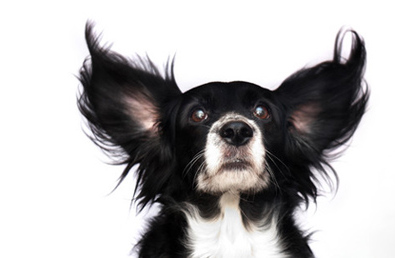It’s certainly not hard to figure out what your dog is telling you when it meets you at the door after you have been out for awhile – the joyful grin and madly wagging tail say it all. Most of us quickly learn our companion’s basic repertoire of overt language. But some of the signals dogs give are subtle or confusing.
Being able to read a dog’s body language is especially necessary for urban dwellers. You not only want to be able to interpret your own companion correctly but, on the street, you want to be able to tell friend from foe.
Learn more about what dogs are telling us with their body language :
1. Hostile tail-wagging. Wagging tails do not always mean friendliness. Say your dog meets a strange dog off the leash. The other dog approaches with great interest, ears alert and tail wagging. But this dog is giving out signals that spell hostility. The wagging tail is stiff and held high. The eyes have a hard expression and stare into your dog’s eyes. The dog’s hackles are raised. The animal’s whole posture signifies aggression. Even without growling or showing its teeth, a dog behaving like this has a chip on its shoulder. You should remove your dog from the scene quietly and quickly.
2. Friendly tail-wagging. A friendly or curious dog’s tail will be wagging in wide sweeps, hanging down. Its ears are down and its fur is smooth along its shoulders and back. The dog will not attempt to look you or your dog in the eye. It will go through the typical sniffing pattern with your dog–first nose to nose, then the genitals. Offer this dog the back of your fist to smell, and then you can probably pet him or her if you wish.
3. “Play” position. Let’s say your dog, after the usual preliminary sniffs, suddenly bounces down on its chest and elbows with its ears flattened and its rear end in the air. Unless the dog’s owner recognizes your dog’s body language, he or she may snatch the animal away protectively, misinterpreting your dog’s behaviour as aggression. Your dog was giving off perfectly clear signals –”Let’s play“– yet was misunderstood. A dog that merely wants to play may also jump excitedly and bark, grin and wag its tail, run around in circles, and roll over.
4. Submissive postures. Sometimes a dog will lie on its belly with its ears flattened and the fur along its back flat and smooth. It looks away and may roll over onto its back. Is it afraid – a coward, a wimp? In most cases not – it may well only be showing submission. It is probably saying, “I am recognizing that you are the boss (pack leader).” Or it could be telling the other dog, “I’m not into power – I don’t want to fight.” A dog that avoids confrontation in this manner usually makes a good dog in an urban setting.
5. Signs of fear. A frightened dog lowers its body, with its tail hanging low or tucked between its legs. Its head is down, its ears are laid back, and its hackles are usually raised. The dog may instinctively crouch close to the ground to protect its belly, and it may approach you and your dog in circles. Because a scared dog can quickly become a fear-biter, the best course is to stand still with your hands by your sides and refrain from looking the animal in the eye. Do not corner it or turn your back on it, but speak to it in a soothing voice. Unless it gets over its fear, relaxes, and shows friendliness or submission, it’s best to move away quietly.




